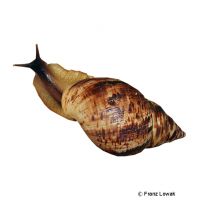African Landsnail (Lissachatina reticulata)
| African Landsnail Lissachatina reticulata | |
|---|---|
| Name | African Landsnail |
| Name Lat. | Lissachatina reticulata |
| Synonym | Achatina reticulata |
| Family | Giant African Land Snails |
| Family lat. | Achatinidae |
| Order | Land Snails |
| Order lat. | Stylommatophora |
| Origin | Tanzania, Zanzibar |
| Habitat | Wetlands |
| Diet | Fruits, veggies, wet cat food, calcium |
| Humidity | 80-90 % |
| Behavior | Nocturnal |
| Keeping | Group |
| Care Level | Moderate |
| Housing | Humid terrarium |
| Breeding | Moderately difficult |
| Life Span | 3-4 years |
| Protection | No |
| Metric Units | |
| Size | 15-20 cm |
| Temperature Day | 28-30 °C |
| Temperature Night | 25-26 °C |
| Housing Size | 80 x 40 x 40 cm |
| US Units | |
| Size | 6"-8" |
| Temperature Day | 82-86 °F |
| Temperature Night | 75-79 °F |
| Housing Size | 30" x 15" x 15" |
Distribution and habitat
Predominantly crepuscular and nocturnal, Genetted Agate Snails are native to southern East Africa and the island of Zanzibar. They live in moist bush savannahs, along forest edges and in cultivated land, where they are considered crop pests.
Maintenance
A terrarium of at least 80 x 40 x 40 cm (L x W x H) for 2-6 animals is recommended. They should be kept at least in pairs, but better in a group. The terrarium should be placed in a quiet place without sunlight.
They need a terrarium with a substrate of terrarium humus mixed with lime soil, at least 10-15 cm deep, suitable for digging and covered with a layer of leaves, so that the pH is 7-8. The substrate must be kept moist at all times. Hidden resting places should be created with strong branches and trunks suitable for crawling, as well as cork tubes. For drinking they need a sufficiently large, shallow water bowl, which is also suitable for bathing. Potted plants (e.g. bamboo, ficus, philodendron, ferns) are advantageous for decoration, as they can be easily removed during cleaning. Several times a day the inside of the terrarium should be finely sprayed with water (humidity), but a rain or mist system is better
| Temp. day: 28-30 °C | Temp. night: 25-26 °C | Humidity: 80-90% |
A thermostatically controlled floor heater or heating mat is recommended. The lighting duration should be 8-12 hours depending on the season. Special lamps with high UV content are not necessary.
Diet
The food supply consists of bananas, apples, pears, cucumbers, tomatoes, lettuce, wild herbs, boiled potatoes, eggplants and oatmeal, but also cat and dog canned food and turtle pellets are readily accepted. It is especially important to add calcium, which is essential for building the shell of the snail, such as cuttlebone or a lime preparation. It is recommended to prepare a lime paste by mixing calcium (e.g. crushed cuttlebone) with crushed fruit and curd or yogurt. The food should be offered on several flat, easy-to-clean plastic plates. Drinking water should be offered fresh daily.
A varied diet promotes health and prevents deficiency symptoms.
Reproduction and breeding
They are hermaphrodites. During mating, they act either as males or females. Self-fertilization is also possible.
The clutch, about 200 eggs, is buried in soft, moist soil. At 28-30 °C air temperature the young snails hatch after 14-18 days. They grow very fast and are already about 3 cm high after 4 weeks.
If you do not want to multiply the snails or control the population, you should look for and remove the 7-9 mm large white-yellow eggs in the substrate every week. They reach sexual maturity already after 10 months with about 7 cm shell height and are fully grown after 13-14 months.
Important
The coloration and patterning of the shell is highly variable, ranging from brown to white with varying patterns.
If kept too dry, the snails bury themselves in the substrate
Acidic fruits should only be fed in a controlled manner and the remains removed immediately, as the fruit acid can attack the snail shell.
Stones must not be used for decoration, as the animals, which occasionally fall from the branches, can injure themselves on them and damage their shells.
Once a week, substrate should be loosened and any clutches should be searched for. It is recommended to change the upper substrate layer once a month.
Good ventilation without drafts is necessary, as well as equipment for measuring temperature and humidity. The lighting has to correspond to the species-appropriate day-night rhythm and has to be installed in such a way that the animals cannot injure themselves
The terrarium should be locked in such a way that neither unauthorized persons can open it nor the animals can escape. Special attention should be paid to thorough hygiene and impurities should be removed regularly. Further literature can be found in your pet store.
References
Text: Serena Werle; Image: Franz Lowak
Source: HENKEL & SCHMIDT (2010): Taschenatlas Wirbellose für das Terrarium, Verlag Ulmer; ENGELMANN & LANGE (2011): Zootierhaltung - Tiere in menschlicher Obhut: Wirbellose, Verlag Harri Deutsch
